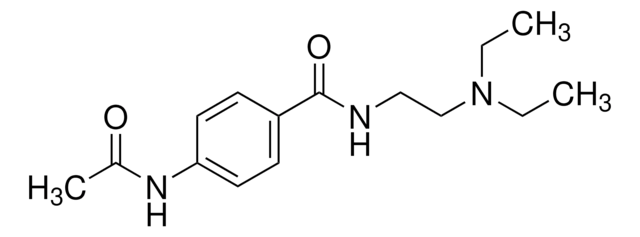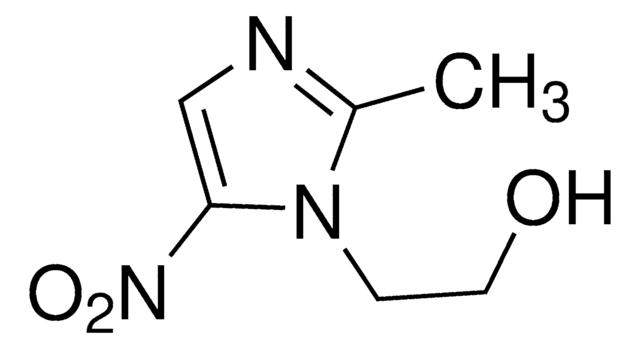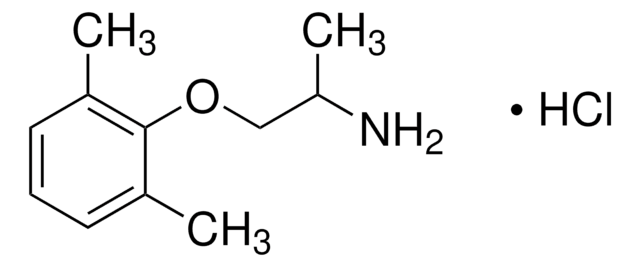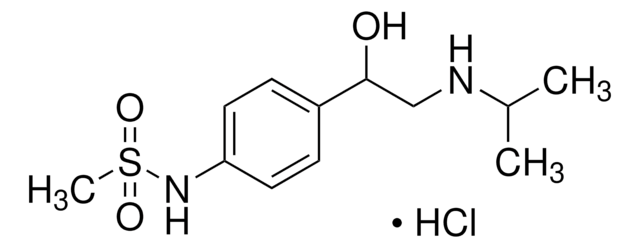全部照片(3)
About This Item
線性公式:
4-(CH3CONH)C6H4CONHCH2CH2N(C2H5)2·HCl
CAS號碼:
分子量::
313.82
EC號碼:
MDL號碼:
分類程式碼代碼:
12352100
PubChem物質ID:
NACRES:
NA.77
推薦產品
化驗
≥99% (HPLC)
形狀
powder
mp
184-186 °C (lit.)
溶解度
H2O: 50 mg/mL
儲存溫度
−20°C
SMILES 字串
Cl[H].CCN(CC)CCNC(=O)c1ccc(NC(C)=O)cc1
InChI
1S/C15H23N3O2.ClH/c1-4-18(5-2)11-10-16-15(20)13-6-8-14(9-7-13)17-12(3)19;/h6-9H,4-5,10-11H2,1-3H3,(H,16,20)(H,17,19);1H
InChI 密鑰
IYEWBJUCJHKLHD-UHFFFAOYSA-N
尋找類似的產品? 前往 產品比較指南
應用
N-Acetylprocainamide hydrochloride may be used:
- as an internal standard for spiking plasma samples for ultra-high-pressure liquid chromatography coupled with a diode array detector (UHPLC-DAD) analysis
- to test its relaxant effect on tracheal smooth muscle tissue preparations
- in preparation of complexes with N-acetyl-L-tyrosine methyl ester and N-acetyl-L-phenylalanine methyl ester for studying intermolecular interactions using nuclear magnetic resonance (NMR) spectroscopy studies
N-Acetylprocainamide hydrochloride is a class III antiarrhythmic compound. N-Acetylprocainamide hydrochloride has been used in a study to determine the disposition of procainamide and N-acetylprocainamide in protein-calorie malnutrition. N-Acetylprocainamide hydrochloride has also been used to study pharmacokinetics of procainamide and N-acetylprocainamide in rats.
生化/生理作用
III 类抗心律失常药。通过降低延时的外向钾电流、稍微降低钙电流以及稍微抑制内向整流钾电流来增大动作电位的持续时间。这是普鲁卡因胺的活性代谢物,不会导致全身性红斑狼疮。
作用于钾电流的 III 类抗心律失常药。
N-acetyltransferase II in liver catalyzes the conversion of procainamide to N-acetylprocainamide (NAPA).
儲存類別代碼
11 - Combustible Solids
水污染物質分類(WGK)
WGK 3
閃點(°F)
Not applicable
閃點(°C)
Not applicable
個人防護裝備
Eyeshields, Gloves, type N95 (US)
客戶也查看了
B L Kamath et al.
Journal of pharmaceutical sciences, 70(3), 299-302 (1981-03-01)
The pharmacokinetics of distribution and elimination of procainamide and its major metabolite, N-actylprocainamide, were studied in rats. Eight rats were selected randomly, and each received intravenously 14C-labeled procainamide hydrochloride (75 mg/kg) or 14C-labeled N-acetylprocainamide hydrochloride (86 mg/kg) according to a
D Jung et al.
Drug metabolism and disposition: the biological fate of chemicals, 13(3), 359-363 (1985-05-01)
The influence of dietary protein deficiency on the disposition of procainamide (PA) and its major metabolite, N-acetylprocainamide (NAPA) was investigated in male Sprague-Dawley rats fed for 4 weeks on a 23 (control) or a 5% (low) protein diet ad libitum.
The evidence for complex formation between N-acetyl-l-tyrosine methyl ester and N-acetylprocainamide hydrochloride using NMR spectroscopy
Janik A, et al.
Structural Chemistry, 20(4), 699-707 (2009)
Larry A Bauer et al.
Antimicrobial agents and chemotherapy, 49(4), 1649-1651 (2005-03-29)
Ten healthy adults participated in a randomized, crossover drug interaction study testing procainamide only, procainamide plus levofloxacin, and procainamide plus ciprofloxacin. During levofloxacin therapy, most procainamide and N-acetylprocainamide (NAPA) pharmacokinetic parameters, including decreased renal clearances and renal clearance/creatinine clearance ratios
M Boucher et al.
Journal of autonomic pharmacology, 18(2), 83-87 (1998-09-08)
1. The cardiac anticholinergic effects of procainamide (1 mg kg(-1) min(-1)) and its N-acetylated metabolite (NAPA) at equimolar dose (1.16 mg kg(-1) min(-1)) were studied using in vivo experimental pharmacological and in vitro radioligand binding studies. 2. Procainamide and NAPA
我們的科學家團隊在所有研究領域都有豐富的經驗,包括生命科學、材料科學、化學合成、色譜、分析等.
聯絡技術服務











